- Home
- Peter Matthiessen
The Cloud Forest Page 6
The Cloud Forest Read online
Page 6
Herr D., among others, deprecates the legends of Indian ferocity. In his opinion the celebrated killings in recent years by the Jivaro tribes of the upper Marañón and the Aucas of the Ecuador border, north of here on the Napo River, were provoked by the rape of an Indian woman in one case, and by total and foolish neglect of Indian customs in the other. The Jivaros have been “contacted” by the missionaries, and pictures and artifacts of this handsome and colorful people, including their toucan-feather headdress, eight-foot blowpipes, and great bows and arrows, are readily obtained. Nevertheless, a German explorer was killed by a sub-tribe of the Jivaros, the Muratos, only a few months ago, a fact extremely vexing to Herr D., who takes hunting safaris into that region. Perhaps he fears that his rather lurid advertising—“Fish with the Chabras Headhunters”—may backfire. Herr D. is sure his fellow German committed some blunder or atrocity, though the facts are still mysterious; he himself claims to have spent six weeks with the Aucas prior to their massacre, a few years ago, of five American missionaries. They are, he says, a very gentle people when they do not feel their rights are being infringed. The one dangerous tribe left in this region are the Mayorumas, or “Mayos,” a short distance southeast of Iquitos on the Brazilian border. (Lieutenant Herndon mentions the danger from the little-known Mayorumas in the journal of his explorations for the United States Navy Department in 1851—“Our men are much afraid of this people”—and an account of 1904, quoted in the excellent Handbook of South American Indians of the Smithsonian Institution, demonstrates that their hatred—or, more probably, fear—of all outsiders is not limited to the white man.
The Mayoruna used to trade with their enemies. They went to the river and blew bamboo trumpets to signal the traders on the opposite side. The latter crossed in canoes and, without landing, held articles for exchange on the points of their spears. The Mayoruna gave parrots, hammocks woven of wild cotton, feather head-dresses, and various small objects, and received knives and other iron tools. The traders then separated, shooting arrows at each other.
In recent years the Mayos have been infiltrated by outlaws—Peruvian, according to Brazil, and Brazilian, according to Peru. Reports received from other tribes by a missionary I spoke to before leaving South America indicate that soldiers of undetermined nationality have recently invaded and wiped out the largest settlement of these Indians, though killing Indians is officially illegal in both countries.)
On New Year’s Day a Captain C., representing a oil exploration company in the area, was kind enough to take myself and some young Germans (Germans are mentioned frequently in this account because they are met with frequently in South America) up the Nanay and Murumu Rivers. These are black, clear streams, and although the wildlife seen was inconsiderable—some large blue-tinged anis, river orioles, egrets, a swallow-tailed kite, a new, black swallow, and a strange community of small bats fastened to a swaying stick out in the open water of the Murumu—I was glad of the chance to see some of the flowers and butterflies close at hand, and especially the great sky-blue morpho; there were numbers of these, some pure blue and some with a black border on the wings, bouncing along in their curious toylike flight.
On our return we paused at the hut of a caboclo; the children there took the odd white guaba and distasteful calomito fruits from the trees for our inspection, as well as the red seed of what looks like a sort of chestnut but is not, used by the Indians as a stain. Captain C., incidentally, swears by the efficacy of Indian medicines, which he claims have cured him of drastic fevers, and of course a number of their medicinal plants are now in general use; oche, one of the poisons used by the Jivaros on their arrows, is an ingredient in tranquilizer pills used in the United States.
The following day I paid a visit to the the Iquitos aquarium and natural history museum, where I had a good look at the nervous red-throated piranha, the great pirarucu—or paiche, as it is called in Peru; most Amazon creatures have both Portuguese and Spanish names, which can be confusing—the giant river turtles, and the dreadful matamata turtle, with its ragged, camouflaged head; the museum upstairs was also useful for verification and identification.
January 3.
From Iquitos, I was anxious to leave by riverboat for Pucallpa, which lies on the Ucayali tributary, six hundred miles farther upstream. But the next boat did not leave for nearly a week, and I decided at last to fly out with the Peruvian military air transport service.
Today is bright, and little puffs of mist hang over the jungle, which is so dense that the ground is closed out entirely. The upper Marañón curves off toward the west, toward the mountains, into the country of the Jivaros—“The region traversed by the Upper Maranhão,” reads the present-day South American pilot, on board the Venimos, “from a point in about latitude 5 degrees, 30 minutes south, longitude 78 degrees, 30 minutes west, is inhabited by warlike and hostile tribes of Indians known as Jibaros, Huambisas, Aguarunas, and Centipos.” We cross a country of bright, algaed sloughs of a sulphurous green, and strange lakes with sharp corners, or shaped like boomerangs—there are an unaccountable number of these—some muddy and some, nearby, jet black; and on up the Ucayali, which, with the Marañón, is a main tributary of the upper Amazon. The river is muddy, creeping up over its banks, and in the bends lie streamlined, sculptured islands. Below, the settlement of Requena, with its rusty roofs of corrugated iron; inland from Requena lie the territories of the dangerous Mayos. The jungle is cut by dark, serpentine creeks with no sign of life along their banks, and now we are over a vast swamp, black water and low clouds: at this height the country can scarcely be told from the coastal swamps of our eastern seaboard, or of Newfoundland, or even of the Yukon delta. But it changes again, a forest of palms, and there is a mirage effect, as if the palms stood suspended above the river water which has flooded them. A sudden storm, and a short time later, with superb Spanish abandon, the plane careens downward through dense clouds, breaking through just above the tree tops, and settles heavily on the mud runway of Pucallpa.
January 3–January 7.
The town of Pucallpa is the terminus of a road across the Andes from the coastal ports and Lima to the Ucayali and the Amazon. In former times Peru had the alternative of transporting its jungle products up over the high mountains by Indian or muleback, or shipping them nearly three thousand miles downriver, around northern South America and through the Panama Canal, and south again to Callao; except for the small amounts that can be taken out by plane, it still has this alternative in the rainy season, for the last part of the road, from Tingo María to Pucallpa, has never been surfaced and becomes all but impassable when wet. The money set aside for surfacing the road has long since vanished, in the graceful and mysterious manner of these countries, but eventually the carretera may be completed, and when this happens Pucallpa will become an important city and may well replace Iquitos as the capital of the jungle. At the moment, however, it is a frontier town, ramshackle and muddy, without a paved street to its name; the great majority of the dwellings here are thatched.
Nevertheless, it is more interesting than Iquitos or Manaus, which might be small towns anywhere. The jungle is very close here, and Indians come into the streets—flat-headed, barefoot Shipibo women, for the most part, with nose ornaments hanging to their upper lips. They wear embroidered skirts and shawls, and thongs tied around their ankles, and their hair, cut in a straight line across their foreheads, extends straight down their backs. The nearest village of Shipibos is about fifteen miles away, at the far end of a large lake, Yarina Cocha. At the near end of this lake is the Peruvian base of the so-called lingüísticos, a group of religious men and women, mostly American, who specialize in the translation of the Bible into the Indian tongues. There are thirty-one distinct languages in the Peruvian selva alone, and the lingüísticos have people working with twenty-nine of these groups—all but the Mayos, who are not hospitable, and one other tribe which is known to exist but which, to date, cannot be found.
I obtained this information, and
a good deal more, from Mr. Jack Henderson, the base director, after an erratic journey to Yarina Cocha by bus and on foot. The work of the Summer Institute of Linguistics, to give the organization its official name, has received a good deal of well-deserved publicity—a converted chief of the Chapras tribe, Tariri, has even appeared on television in Hollywood—and there seems no reason to celebrate it here, but Mr. Henderson was also very helpful in regard to local information and confirmed two stories I had heard downriver. First of all, missionary work throughout the selva has recently been hampered by the natives’ conviction, spread by their medicine men, that Indian flesh and its oil are used as fuel for the white man’s airplanes. And second, one of the lingüísticos, a girl, was actually attacked by an anaconda. For once Colonel Fawcett had been borne out, and so had my friend Picquet in Belém. Apparently, the girl involved was sitting in a canoe at the river bank in front of a Chapras village, awaiting her partner, a trained nurse, when the river boa rose behind her and seized her at the elbow. She was able to fight free of it and reach the bank, but not before being bitten severely on the arm and side; the incident was witnessed and confirmed, apparently, by the girl’s partner and the Indians themselves, and she still has the scars to prove it.
Mr. Henderson recommended to me an independent missionary in the nearby village for further information as to wildlife, and, after a fine lunch served by his wife, I walked back down the jungle road. Songbirds and doves were everywhere, including a black finch with a luminous breast of dark, deep red; there were also two kites, which are common around Pucallpa.
The missionary, Mr. Joseph Hocking, came to his calling indirectly, having formerly been an expert on snake venoms and anti-venins for the pharmaceutical firm of Sharp & Dohme; he is an enthusiastic amateur naturalist and still corresponds with museums and zoologists in the United States. Mr. Hocking is a bald, cheerful man with an attractive family, and his specialty is aiding the local people toward improved agricultural practices. He operates an experimental fruit farm—he fed me a variety of fine mangoes—and raises the only prosperous chickens I have seen to date in South America, feeding them a nutrient meal of his own invention consisting of ground-up caimans. Formerly, he said, large caimans were so common in Yarina Cocha that at times the airplanes of the lingüísticos had difficulty finding a clear path in which to land. The big animals are rare now—in part, he admits, because of the local industry he himself set up by advocating their use as chicken feed. According to Hocking, the caimans will attack, though usually when cornered, by accident or intent, in a narrow place or slough. Snakes and snakebite, in his experience, are much exaggerated dangers, though the bite of the bushmaster, called by Fawcett “that double-fanged abomination,” is almost invariably fatal in a matter of minutes. (The bushmaster is commonly twelve feet in length, enormous for a pit viper, and the quantity of its peculiar venom so great that even if a quantity of serum was at hand, a sufficient amount could not be transmitted to the victim in time to save his life.) But the bushmaster is nocturnal in its habits, as is the more common fer-de-lance; both of these species, with the large variety of other venomous snakes, usually succeed in keeping out of man’s way. Hocking supports the usual theory about that small but notorious destroyer the piranha, that it will not attack unless blood is in the water; the piranha is common in Yarina Cocha, but children swim there freely nonetheless. Mr. Hocking’s children keep a pet tapir, a matamata turtle, and a small boa constrictor on their premises, which are lively and cheerful. I hope it won’t embarrass Mr. Hocking if I report here that he is extremely well liked and respected throughout this region.
Mr. Hocking’s remarks on the crocodile, piranha, and poisonous snakes tend to bear out the results of my own unscientific survey of the dangerous fauna of the Amazon. A number of intelligent people, including a few who can be considered trustworthy, were earnestly consulted. Here are the dubious conclusions: in answer to the question, What do you think is the most dangerous creature in the Amazon? (or, Qué a su opinión, es el animal el más peligroso de Amazonas?), the name which came up most often was that of the sucurucu (Brazil), or shushupe(Peru)—the bushmaster. Next came the gergón (Peru), or jararaca (Brazil)—the fer-de-lance. And this was true despite the fact that, according to many, it is possible to walk through the selva for days at a time without seeing a snake of any description. This leads one to suspect that the two largest of the venomous snakes are less prevalent than awe-inspiring. (Hocking, in fact, tells a terrible story which he believes to be true: not long ago, in Brazil, two men played a joke on a sleeping friend by slapping him on the arm with two thorns on a stick after placing a live bushmaster on the floor. Seeing the bushmaster and the two spots of blood upon awaking, the man was convinced his doom was sealed and dismissed his friends’ frantic reassurances as attempts to comfort him; within fifteen minutes he had died of shock.)
No other creature received more than a single vote. Few jungle veterans have ever seen an anaconda large enough to do them damage (to Fawcett, perhaps, this would indicate that few have ever done so and lived to tell the tale); the giant specimens—thirty feet is very big indeed—usually occur in ponds or swamps, away from the traveled rivers. (Nevertheless, an imposing source of information, the well-known jungle hand and hôtelier of Pucallpa, Señor Fausto Lopez, has described to me this very day an anaconda which he saw killed by Indians during the course of a journey by raft, or balsa, down the Huallaga River from Tingo María to Iquitos; this animal, which the Indians assured him was old and harmless, measured thirty meters, or more than ninety feet, in length.) The jaguar has some kills to its credit, but these are extremely sporadic, at least in the Amazon: the evidence seems to suggest that el tigre, like the other great cats of the world, is chiefly dangerous when wounded, or when so old and decrepit that human beings are the best it can manage in the way of food. The electric eel, tarantula, scorpion, vampire bat, and other creatures can all be deadly under special circumstances; a missionary from near Atalaya has never known a fatal case of snakebite but has lost a young Indian to a scorpion. In general, however, these small things are considered pests: the vampire, with its swift digestion, adds insult to minor injury by befouling the sleeping quarters of its victim. In the end the creatures most disliked are the biting insects and the candiru. These are not fatal, and the conclusion one must come to—not without a certain loss of romantic illusions—is that a human death caused by any one of the dread denizens of the jungle is so rare that Theodore Roosevelt once called potential danger from these animals “trivial.” The rare animal fatality, however, coupled with those caused by disease, drowning, starvation, and, very occasionally, wild Indians, reminds one of the forces still operative in this huge river world.
There is a man in town named Vargaray, from upriver at Atalaya, known locally as an hombre muy serio—not given, that is, to flights of fancy—who has seen a fossil mandible lying in the jungle near the Inuya River so huge and heavy that “five or six men” could not lift it. I expressed my doubt politely, I thought, by inquiring why the missionaries in the area had apparently never seen or heard of this phenomenon, and Vargaray retorted, not without mild contempt, that the misionarios knew nothing of the selva except the Indians of the few small villages on the bank where they had elected to spread the Word. A friend of mine, Señor Cruz, subsequently vouched for Vargaray, as did Señor Raul de los Ríos, whom Mr. Hocking describes as a fine naturalist and taxidermist, and who is plainly an educated man. And it is true that fossil mammoths have been discovered in South America, though none so huge as to satisfy Vargaray’s description. His story, like most stories of the Amazon, leaves one with a nagging doubt, a fleeting impulse to scrape up an expedition and go plunging off into those imperturbable green walls.
Here at Pucallpa the jungle is visible from my window in the Gran Hotel Mercedes; it lies but a short distance away, on the far side of the Ucayali. Tomlinson’s Englishman of Belém never seemed more right: it seems to wait. But in Pucallpa, where tourists a
re a novelty, a man who says he wishes to go to the jungle simply to look at it is not taken seriously. A Peruvian who might rent his boat is never there, and the assurances of my new friends—one makes friends quickly in Spanish countries, and loses them just as fast—that something can be arranged never seem to come to flower. In consequence, I shall leave the Amazon tomorrow with the uneasy feeling that the jungle has eluded me.
And yet a curious apathy has overtaken me. I can’t say that I’m not frustrated, but I can see how tempting could become the Latin concept of mañana, that eternal procrastination so foreign to us brisk northerners. It is particularly insidious in an outpost like Pucallpa, cut off from the world by the jungle and the river, the road out impassable much of the year. For example, I am ignorant of what has happened in the world in the past month and do not care—mañana I shall find out. I sit with the rest and drink and wait, and watch the hogs and vultures in the muddy street. Sometimes, in a desperate attempt to pierce the jungle, I journey out of town on the tiny bus, or on a truck, poor great gringo that I am, swaying above the press of small humanity like a praying mantis in a beehive. Miles later I get off and unlimber all my optical accouterments, but I am really more an object of curiosity than an observer, for the jungle I glimpsed along the river is never really there, not that jungle of giant trees and mystery which stays always in the distance. The most interesting object I have seen here, in fact, was a large green iguana, which I found downtown, consorting with some hogs. The humidity defeats me after a while, and I hobble back to town in my explorer’s boots for the siesta. My skin, dark brown three weeks ago, appears to have turned yellow. At night large frogs appear in the deep rain ruts of the street and fill the darkness with a sound like Chinese blocks, and a bat whirls up and down the upstairs corridor of the Mercedes. Early in the morning men dead drunk on the cane alcohol, kachasa, reel past, talking to the pigs, and another man, not drunk at all, plays a guitar as he goes along and sings in a clear voice a repetitive, sad huainu of Peru.

 Lost Man's River: Shadow Country Trilogy
Lost Man's River: Shadow Country Trilogy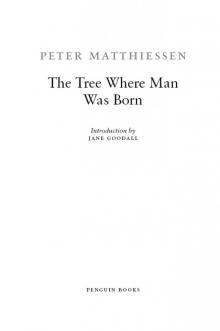 The Tree Where Man Was Born
The Tree Where Man Was Born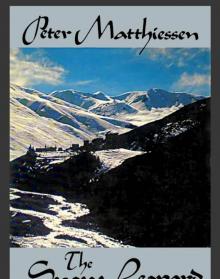 The Snow leopard
The Snow leopard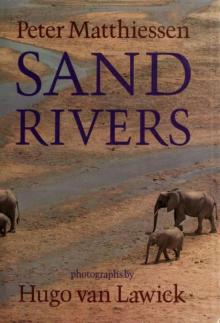 Sand Rivers
Sand Rivers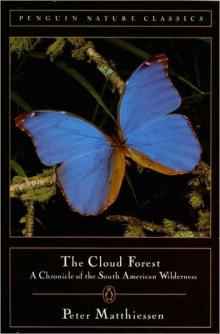 The Cloud Forest
The Cloud Forest Sal Si Puedes (Escape if You Can)
Sal Si Puedes (Escape if You Can) Far Tortuga
Far Tortuga Men's Lives
Men's Lives On the River Styx: And Other Stories
On the River Styx: And Other Stories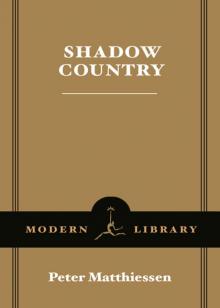 Shadow Country
Shadow Country At Play in the Fields of the Lord
At Play in the Fields of the Lord Lost Man's River
Lost Man's River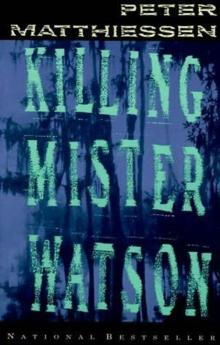 Killing Mister Watson
Killing Mister Watson On the River Styx
On the River Styx